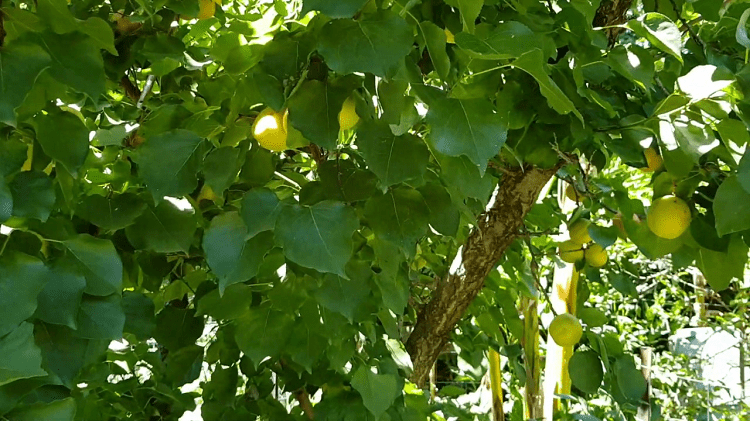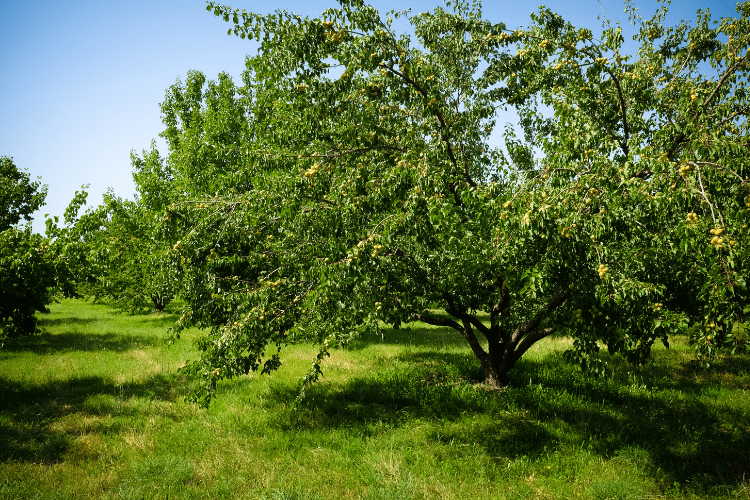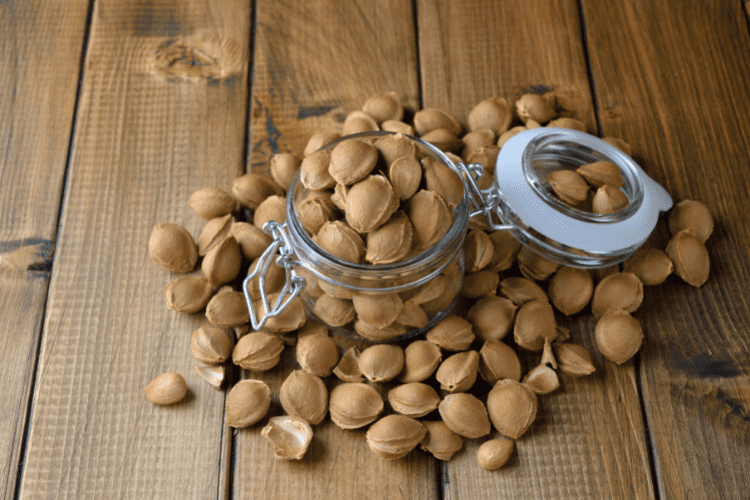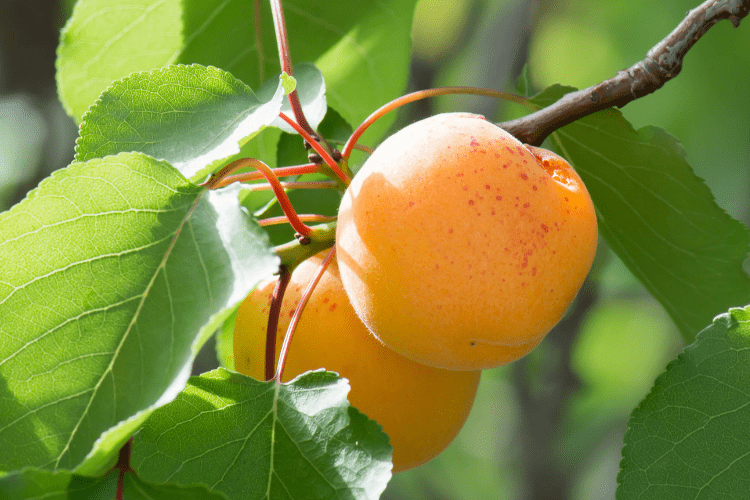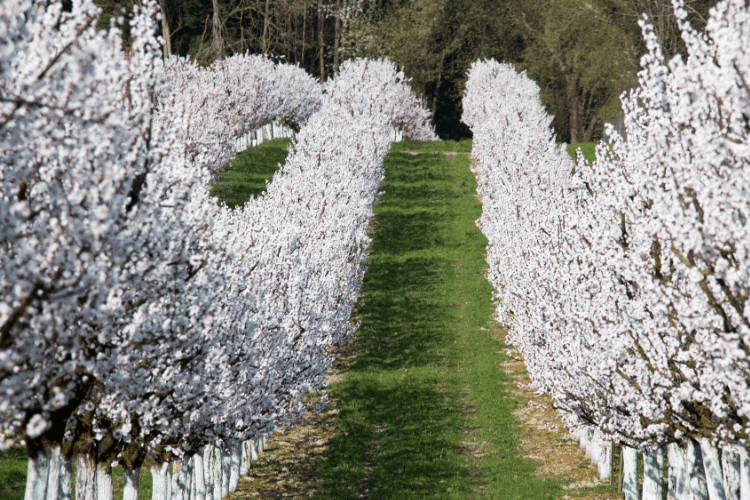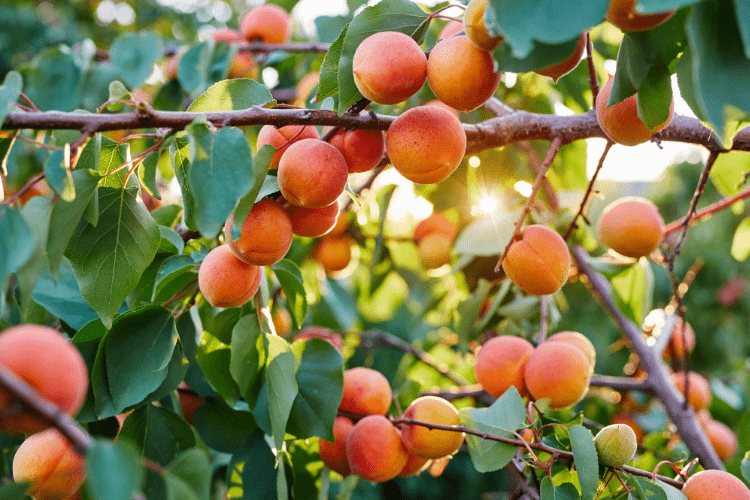- Apricot Tree: Can You Really Grow It On Your Own? - November 29, 2021
- Lavender Tree: How Soon Your Can Expect Your Tree To Grow? - November 2, 2021
- Bottle Brush Tree: Can You Grow It In Your Own Yard? - November 2, 2021
The Apricot tree is a deciduous fruit tree that grows from 26 to 39 ft in height. In the United States, apricot trees grow mostly in California, Washington State, and Utah. In Zone 4 climates with cold winters and summers, the cold-hardy apricot tree species can grow well.
These include states such as Colorado, Maine, Arizona, Idaho, Iowa, Michigan, Minnesota, Montana, Nebraska, Nevada, New Hampshire, New Mexico, New York, North Dakota, Oregon, South Dakota, Utah, Vermont, Washington, Wisconsin, and Wyoming.
There are many different varieties of Apricot trees, and we will discuss some of the different requirements to grow and care for them.
How to Identify Apricot Trees
The best time to observe an apricot tree is in May and June, when the fruit blossoms on the trees Most of these trees bear fruit in the early summer and produce blossoms in the spring. The fruit resembles a small round orange or yellow fruit, like a small peach. Sometimes, the trees do not bear fruit, so you have to use other ways to identify them. These are as follows:
- Apricot trees grow 20 to 30 feet in size
- They grow well in sunny areas with well-drained soil
Another way to determine an apricot tree is to look at the blossoms on the trees. In the warmer climates, they grow in early spring and summer. The blossom color is pink, red, and white and has a spicy scent. The leaves are heart-shaped with jagged edges.
Where Do Apricot Trees Grow
Apricot trees grow in Turkey, Italy, Uzbekistan, Algeria, Iran, Pakistan, Spain, France, Afghanistan, and Morocco. These trees grow well in warm climates with stable weather conditions. In the United States, they do best in warm climates with dry air like California and Zones 4-8. California is the leading producer in the United States for growing apricots with Washington, and Utah next.
When you live in an area with cold winters and warm summers, you can still grow these trees, but with great difficulty.
Types of Apricot Trees for Home Gardeners
There are many diverse types of apricot trees to grow. We will be discussing apricot trees that can be grown at home in Zones 4- 9 in the United States.
The Patterson Apricot Tree
The Patterson Apricot Tree grows in Zones 4-9 with cold winters and hot summers. The tree produces a heavy crop of apricots, and the fruit size is large. These trees are self-pollinating and are an excellent choice for hobbyists and those with home gardens. They are ideal for those with limited space.
Patterson Apricot trees need to be kept at a 45-degree temperature for 700 to 1000 hours. It can grow 15 to 30 feet high and is suited for larger yards.
Plant the tree in a sunny area with plenty of room to grow. This tree needs plenty of sun, weekly watering, and pruning. It’s best to buy a tree to plant from a grower or garden centre because most trees are cultivated by grafting.
Perfection Apricot Tree
Perfection Apricot Tree grows in Zones 4-8. It is a small tree designed for small yards or orchards. It grows 6 to 8 feet in height, and the apricots are large. It is an extremely popular variety with commercial producers.
This tree is self-pollinating, making it ideal for home gardens. It grows best in well-drained soil, and the roots should remain moist or wet. Plant the tree in a sunny area, water regularly, and prune regularly. It needs 500 hours of cold temperatures and does well in climates with cold winters.
Moorpark Apricot Tree
Moorpark Apricot Tree grows in Zones 5-8. It grows 12-20 feet high and spreads 12-15 feet across. It often produces fruit in the first year. This tree has white blossoms and is planted for its ornamental beauty. This self-pollinating apricot tree can be planted alone. Plant this tree in well-drained soil, a sunny spot, and water it regularly.
It is low maintenance and produces small apricots. It needs 6 hours of sun or more and should be watered at least once a week. The dwarf Moorpark apricot tree can be grown indoors. You must prune it regularly to keep it inside your home or apartment. It needs watering and a combination of shade and sun to produce tasty fruit.
Harglow Apricot Tree
Harglow Apricot Tree grows in Zones 4-8 and is 12-15 feet high. It is a low-maintenance tree and resistant to disease. This tree is small and well-suited to backyards and small gardens. It grows in the Pacific Northwest and other areas. The tree does well in cool, wet regions.
The apricot tree is medium-sized and blooms late in the summer, making it more resistant to frost. This dwarf apricot tree is self-pollinating. It grows well in full sun and loamy soil that drains well. It needs moderate watering and should be sprayed with copper spray at intervals to prevent infestations. This tree does well with moderate pruning.
Chinese Mormon Apricot Tree
Chinese Mormon Apricot Tree is a small tree that grows in Zones 5-9 and up to 15-20 feet tall. It is a self-pollinating tree that requires 700 hours of cold temperatures. It does well in climates with a late spring frost. In the spring, it has white and pink blossoms and produces apricots after 3-5 years.
It does well alone but propagates better with another Chinese Mormon Apricot tree nearby. Plant in full sun and water regularly by inserting a stick in the ground near the base to see if the soil is moist or dry. When dry, water the tree to reach the roots.
Prune to remove all damaged branches and limbs. Adding a layer of mulch will help protect the roots and conserve water.
Puget Gold Apricot Tree
Puget Gold Apricot Tree grows in Zones 5-9. It can grow 10 to 15 feet high and has dwarf varieties. It can be grown indoors and needs 600 hours of cold or winter weather.
Plant them in the direct sun and water weekly; do not overwater as this tree can develop root rot. This tree should be pruned at the end of summer and planted in soil that drains well. It takes one or more years to bear fruit. Young trees can range from 5- 8 feet in height.
Tilton Apricot Tree
Tilton Apricot Tree grows in Zones 4-9 and needs about 600 hours of cold temperatures. It does well in climates with chilly winters and warm summers. It blooms late in the summer and produces a hearty crop of apricots.
The fruit is heart-shaped, and it is a self-fertilizing tree. These medium-sized trees should be planted at least 20 feet apart and away from patios and driveways. It needs sun, one inch of water every week, and pruning in fall or late spring.
How to Grow Apricot Trees From Seed
When you grow apricot trees from the seed, the pits (where the seeds are enclosed) need preparation. Clean the pits in water to remove any sticky material or pulp, then dry them for a few days on a clean cloth or paper towel. The seeds are located inside the pit, which protects them. You can crack the pit slightly with a nutcracker or pliers to expose the seeds. This helps them to germinate.
The seeds must be chilled for a few months to prepare them for planting, and temperatures must be 45-50 degrees Fahrenheit. Some consumers moisten moss or paper towels and put the seed into an empty glass or plastic container in the refrigerator.
You can plant the seeds in pots and put them outside in the winter to let nature chill them for you; they should be chilled for two to three months. Sow the pits deep underground because animals like to eat them. Start them in 1-to-2-quart pots and put them in a soilless potting mixture. This mixture will likely not rot the pits and is recommended by growers. Put them about two inches in the soil, cover well, and water lightly.
Keep the tree pits inside in a bright sunny location until the weather is warmer when they begin to germinate. If you have a greenhouse, they can be placed there. The seed needs to be kept warm after chilling to germinate and grow.
They germinate best when temperatures are 86 degrees F, and the night time temperature reaches no lower than 68 degrees. In cool areas, you may want to use a heat mat or light for germinating the seeds after chilling. Talk with your local garden centre about how to use this equipment.
The seeds should be watered when the soil is dry and take about four to seven weeks to grow. After they start to grow and show some leaves, you can transplant them into 1- or 2-gallon pots with potting soil. Let them grow outside in the light, and plant them into the ground in the fall.
Choose a location with full sun and good soil drainage and plant 10 to 20 feet apart for each tree planted. Dig a deep hole in the ground and add compost to the soil. Mix this with some gardening soil.
Put the tree into the hole and spread the roots. Spread a few inches of mulch around the base of the tree or trees. You should feed the tree a recommended fertilizer by your garden centre for a few weeks to a month after planting.
When to Plant the Apricot Tree
The best time to plant an apricot tree is in the fall. This is because it allows the tree to establish its roots before the cold winter weather sets in. Here are some things to remember when planting:
- Choose a late blooming variety of apricot trees to plant because frost can destroy the blossoms and ruin the fruit for the season.
- Choose a sunny spot with good soil drainage that is free from winds and poor soil drainage.
- Choose a spot that is not near other trees and telephone wires. Give it the space to grow.
- When planted in the spring it should be planted when the danger of frost is gone.
- Choose a sunny spot with well-drained soil, water when soil is dry.
- Use fertilizer recommended by garden centre or grower.
How to Plant Apricot Trees
Apricot trees can be purchased as bare roots, with burlap bags over the roots and planted in containers. If you are buying an established tree, it is better to buy from a local garden center or grower.
Plant bare root trees in early spring. Remove the burlap bag or container from the roots before planting. Try to plant seedling or trees before the hot dry weather comes. Plant in a location with full sun that does not have strong winds or breezes.
Apricot Tree Water Requirements
The first year you should water your apricot tree when dry, which is about once every 10 days. Let the water from the hose trickle into the ground, and water the base of the tree specifically. Some gardeners use a soaker hose if they have more than one tree. Be sure to let the water seep into the ground and reach the tree roots. However, remember that too much water can produce root rot.
You can evaluate the soil by using a stick to see if it is dry or moist. It should be inserted several inches into the ground. You can purchase a moisture meter to measure the water level or moisture in the soil. Insert the moisture meter into the ground before watering. When the meter reads between one and three, it means the soil is dry.
Best Apricot Tree Fertilizer
Test your soil before fertilizing the apricot tree because when your soil lacks nitrogen and phosphates you should choose a fertilizer that meets these deficiencies.
Nitrogen encourages growth of leaves and branches and phosphorus helps the growth of blossoms and roots. A water-based fertilizer designed to be used on apricot trees is recommended by growers. In rich soil, you may not need fertilizer until the fruit begins to grow.
In the first year, if your tree does not grow well it should be fertilized the following spring. The best kind of fertilizer is a well-balanced fertilizer like 10-15-10. Ask your garden center or orchard to recommend a brand and how to use it.
A good fertilizer will have nitrogen, phosphorous, and potassium in it. Brands to consider are Dr. Earth Fruit Tree Fertilizer or Jobes Fruit and Nut Tree Fertilizer.
Best Apricot Tree Companion Plantings
Basil is a good herb plant to put near apricot trees. The scent of the basil will repel fruit flies and should be planted near the base of the tree. Remove any flowers from the herb as this diminishes the scent of the plant. Onions, garlic, leeks, and chive will keep insects that bore into the tree from coming around.
Some growers say chives are the best of these plants and attract pollinating insects too. Strawberries and grapes are good companion plants for apricot trees. Pansies are also excellent flowers to plant, as they attract butterflies and bees.
On the flipside, some vegetables can cause harm to an apricot tree because they can transfer disease and bacteria. Some of these vegetables are tomatoes, peppers, and eggplants.
Apricot Diseases and Common Problems
Insects
Aphids
These are tiny green insects with pin sized heads that suck the plants juices. They produce a sticky substance that attracts ants and other insects. The symptoms of the disease on the tree are yellow leaves that fall off and die, as well as sooty mould.
This can be controlled with insecticidal sprays or a spray of water from the hose to remove the aphids from the branches and leaves.
Mites
These are tiny bugs that are hard to see that can infest your apricot tree causing leaf and fruit damage. Applying an insecticidal soap in the spring is recommended by growers.
There are several kinds of caterpillars that can eat the leaves and bore into the fruit of the tree every season. They should be removed by hand and sprayed with a pesticide that kills them but not the fruit or tree.
Borers
These are insects that hatch in the spring and bore or tunnel into the tree eating its nutrients. They lay eggs in or near the tree that hatch in the spring.
Prevent this by keeping the apricot tree healthy and pruning the tree and removing the branches, leaves, and fruit with infestations. These insects kill the tree once they tunnel inside.
Leafrollers or small caterpillars are another pest that harms apricot trees. They should be sprayed to get rid of them. The best time to spray is winter and autumn or spring before the eggs hatch.
Diseases
Rainy Weather and Early Frost
This can cause bacterial canker on apricot trees. The branches develop cankers and wet spots. The leaves turn brown, and the fruit develops sunken brown areas.
Pruning areas with the bacterial canker and disinfecting your tools is advised. Destroy the diseased branches do not use for mulch and consider using a dressing for tree damage that prevents re-infection. Prune in early summer to treat this problem and contact your local agricultural or garden centre to learn about products to treat this condition.
Brown Rot
This is another disease that occurs in spring in warm wet weather. It produces fungus and cankers on infected limbs and branches. Prune branches and areas with brown rot and disinfect tools and remove debris. Get a recommended insecticide spray from your garden centre, grower or horticultural extension.
Powdery Mildew
This is a common disease you will want to avoid. It presents as grey mould or spots on the tree branches. It can infect branches, buds, and fruit. The leaves curl and die. The fruit develops white spots that turn brown or pink. Growers recommended treating the infection by spraying with Neem Oil.
Pruning your apricot tree regularly will help prevent infection. Scab produces green spots on leaves that eventually turn black. The leaves fall off and the fruit develops spots at the stem and often become deformed and knotty. Remove leaves and infected fruit and prune regularly. Spray with recommended fungicide from your garden centre or Neem oil.
How to Remove Apricot Trees
An established apricot tree should be removed by a tree service as they can dig the tree out and grind the stump and roots if it has become diseased. When you want to transplant the tree and it is a younger tree you can dig a hole around base and down under the roots to loosen the tree.
Dig down as deep as you can to remove the tree and to get the entire root system. When you plan to transplant it to a different location and it is too large call a tree service to help you dig it out with the roots and to transplant in another location.
Where to Buy Apricot Seeds Online
Best Seeds Online
This company sells apricot seeds in different quantities of 2, 5, 20, 60, and 100. The seeds are reasonably priced, and the company is located in the Netherlands. The ads do not specify the type of apricot tree grown. But when you are starting out this is an excellent product to try.
They have a product refund policy and if your product is damaged, they have a form to fill out , and you must send photos of the damage. They provide free shipping worldwide and during holidays wait times for the products are longer.
Tree Seeds
This website sells apricot seeds the type of tree is not specified. They sell in quantities of 25 to 1,000 seeds. They sometime run out of stock you may want to call to find out when they will have more in stock again.
They ship using first class and priority mail in the United States. Their seeds are GMO free, and they are located in Burlington, Vermont. The apricot tree sold grows to 26- 39 feet tall you will need a large yard for this species. They have a number to call to for more information on ordering and how to use the seeds at 1-802-210-2134.
Esty
This independent sell marketplace sells apricot tree seeds through different vendors. Popular vendors are The Seed House Tr54, Oreshkaseeds, and CZGrain. The seeds have received complimentary reviews from customers that bought them.
eBay
This global online marketplace sells a variety of apricot tree seeds to plant. The prices are reasonable, and eBay refunds you your money back when you do not receive the right product that you ordered. There is free shipping on some apricot tree seeds other charge varying rates for shipping.
Where to Buy Apricot Saplings or Apricot Trees Online
We would recommend buying a young apricot tree over a sapling when growing the tree. It is already established, and you can plant it in a pot or outdoors. The young apricot tree will vary in size.
Many growers in the United State will ship the tree to your home when they are available. Most growers sell young trees in varied sizes, and you can order online and choose the size you want. They will sell the trees bare root or potted in containers.
Willis Orchard Company
This company sells young apricot trees in varied sizes online from 1 to 8 feet in height. They often prune their apricot trees before sending so it may be shorter than the height specified. You can place an order online or by filling out their form and they ship FedEx ground.
They sell several varieties of Apricot trees, and many are self-fertilizing and can be grown in several zone in the United States. The company is in Georgia, and they cannot ship some products to California.
They sell the following apricot trees Autumn Royal, Blenheim, Garden Anne Dwarf, Moorpark, Mume Apricot, Plumcot Hybrid, Royal, and Tropic Gold. They also allow returns for damaged products, but you must keep the box and provide photos.
Nature Hills Nursery
This company in Omaha, Nebraska sells a variety of apricot trees online. The trees are sold in potted containers or dormant bare roots without soil. They often come in 1–3-foot sizes. You can buy trees that are 18 months to 4 years old.
The Apricot trees they sell are Autumn Glocot, Blenheim, Katy, Chinese, Moorpark, Golden Sweet, White Knockout, Puget Gold, and others.
Grow Organic
This company found in Grass Valley, CA grows bare-root apricot trees that are 2 years old. They are shipped in special containers with sawdust to protect the tree roots. Some of the trees are for warm climates and others for colder climates. Many of the bare root apricot trees are semi-dwarf in size. and they sell trees that are in pots and soil.
They sell several varieties of apricot trees. They use USPS and FedEx to ship and orders go out within a few days after ordering. You can call or order your product online and they ship to most states in the United States. The website has instructional videos and articles on planting and caring for trees and customer service agents are helpful.
FAQs
Answer: When germinating, they respond best to cold temperatures, so it is best to set seeds outside during winter. Then when established, these trees do best when in warmer climates.
Answer: Apricots are a versatile fruit. You can use them for Jams, put them in yogurt, or you can even use them in some savoury dishes like salads, pastas and curries.
Answer: For our money, we would say that these are the easiest fruit trees to grow:
• Cherry tree
• Fig trees
• Orange trees
• Lemon trees
Conclusion
Growing apricot trees can be challenging because they need a great deal of attention and care. We would recommend buying a young tree or bare root tree from an established grower over planting it from seed.
Plus, you have any issues, remember that your local garden centre is a resource to be used and will be more than happy to offer advice on how to help your Apricot tree flourish. So get out there and grow some tasty Apricots!



